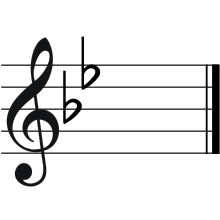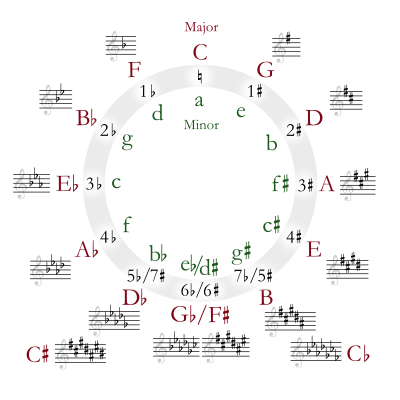G minor
 | |
| Relative key | B♭ major |
|---|---|
| Parallel key | G major |
| Dominant key | D minor |
| Subdominant | C minor |
| Component pitches | |
| G, A, B♭, C, D, E♭, F, G | |
G minor is a minor scale based on G, consisting of the pitches G, A, B♭, C, D, E♭, and F. For the harmonic minor scale, the F is raised to F♯. Its relative major is B-flat major, and its parallel major is G major.
Changes needed for the melodic and harmonic versions of the scale are written in with accidentals as necessary. G minor is one of two flat key signatures that require a sharp for the leading-tone (the other is D minor).
Mozart's use of G minor
G minor has been considered the key through which Wolfgang Amadeus Mozart best expressed sadness and tragedy,[1] and many of his minor key works are in G minor, such as the Piano Quartet No. 1 and the String Quintet in G minor. Though Mozart touched on various minor keys in his symphonies, G minor is the only minor key he used as a main key for his numbered symphonies (No. 25, and the famous No. 40). In the Classical period, symphonies in G minor almost always used four horns, two in G and two in B-flat alto.[2] Another convention of G minor symphonies observed in Mozart's No. 25 was the choice of E-flat major for the slow movement, with other examples including Haydn's No. 39 and Johann Baptist Wanhal's G minor symphony from before 1771 (Bryan Gm1).[3]
Notable works in G minor
- Dido's Lament (When I am laid in earth), aria from the opera, Dido and Aeneas – Purcell
- Sonata No. 1 in G minor, BWV 1001 – Johann Sebastian Bach
- Fantasia and Fugue in G minor "The Great", BWV 542 – Johann Sebastian Bach
- The Four Seasons (Vivaldi) Summer, RV315 - Antonio Vivaldi
- Symphony No. 83 "The Hen" – Joseph Haydn
- Symphony No. 40 – Wolfgang Amadeus Mozart
- Ballade No. 1 in G minor – Frédéric Chopin
- Polonaise in G minor – Frédéric Chopin
- Piano Concerto No. 1 – Felix Mendelssohn
- Piano Concerto No. 2 – Camille Saint-Saëns
- Slavonic Dance No. 8 in G minor – Antonín Dvořák
- Sicilienne, Op. 78 – Gabriel Fauré
- Piano Concerto No.4 in G minor - Sergei Rachmaninoff
- Prelude in G Minor – Sergei Rachmaninoff
- Sonata for Cello and Piano in G minor – Sergei Rachmaninoff
- Much of Giuseppe Verdi's Requiem, specifically the Dies Irae, is in G minor.
- Concerto No. 2 in G minor, Op. 8, RV 315, "Summer" from The Four Seasons – Antonio Vivaldi
- Adagio in G minor – "Albinoni's Adagio", now attributed to Remo Giazotto
- Violin Concerto No. 1 in G minor, Op. 26 – Max Bruch
- Christmas Concerto – Arcangelo Corelli
- Carol of the Bells – Mykola Leontovych
- Hungarian Dance No. 5 – Johannes Brahms
- Cataluña – Isaac Albéniz
See also
- Key (music)
- Major and minor
- Chord (music)
- Chord names and symbols (popular music)
- List of symphonies in G minor
References
- ↑ Hellmut Federhofer, foreword to the Bärenreiter Urtext of Mozart's Piano Quartet in G minor. "G-Moll war für Mozart zeitlebens die Schicksaltonart, die ihm für den Ausdruck des Schmerzes und der Tragik am geeignetsten erschien." ("G minor was, for Mozart, the most suitable fate-key throughout his life for the expression of pain and tragedy.")(
- ↑ H. C. Robbins Landon, Mozart and Vienna. New York: Schirmer Books (1991): 48. "Writing for four horns was a regular part of the Sturm und Drang G minor equipment." Robbins Landon also notes that Mozart's No. 40 was first intended to have four horns.
- ↑ James Hepokoski og Warren Darcy, Elements of Sonata Theory (Oxford University Press: 2006) p. 328
External links
 Media related to G minor at Wikimedia Commons
Media related to G minor at Wikimedia Commons
| Diatonic scales and keys | |||||||||||||||||||||||||||||||||||||||||||||||||||||||
|---|---|---|---|---|---|---|---|---|---|---|---|---|---|---|---|---|---|---|---|---|---|---|---|---|---|---|---|---|---|---|---|---|---|---|---|---|---|---|---|---|---|---|---|---|---|---|---|---|---|---|---|---|---|---|---|
 |
| ||||||||||||||||||||||||||||||||||||||||||||||||||||||
| The table indicates the number of sharps or flats in each scale. Minor scales are written in lower case. | |||||||||||||||||||||||||||||||||||||||||||||||||||||||